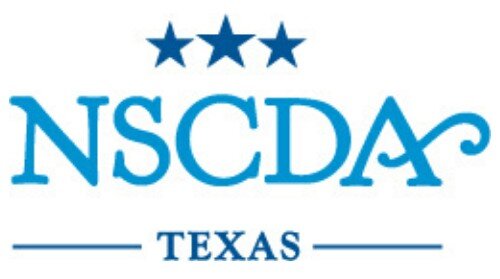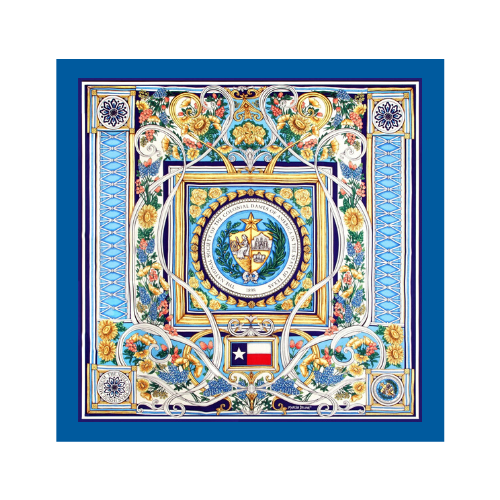The National Society of The Colonial Dames of America in the State of Texas
The National Society of The Colonial Dames of America in the State of Texas, incorporated in 1898, became the thirtieth Corporate Society to become a member of
The National Society of The Colonial Dames of America. The original charter was signed by twenty-two women in Austin, Texas, on February 22, 1898. Because of its central location in Texas, Austin became the headquarters of the Society. The size of Texas necessitated the formation of local Town Committees. In addition to one At-Large Committee there are now eight Town Committees: Austin, Beaumont, Dallas, El Paso, Ft. Worth, Houston, San Antonio, and Waco. The Texas Society has approximately 650 members.
Our charter members
Mrs. Samuel M. Welch
Mrs. J. L. Henry
Miss Julia M. Pease
Mrs. George F. Pendexter
Mrs. Albert S. Burleson
Mrs. William H. Tobin
Mrs. Thomas B. Lee
Miss Mary Josephine Palm
Mrs. Claude D. Johns
Mrs. John A. McClellan
Mrs. Benjamin F. Weems
Mrs. Swanie Robertson
Mrs. C. Lombardi
Mrs. J. M. Wendelken
Mrs. A. P. Cary (later Mrs. James N. Burns)
Mrs. J. R. Currie (later Mrs. J. C. Muse)
Mrs. Lewis M. Dabney
Mrs. C. C. Kinney
Mrs. George T. Winston
Mrs. A. H. Belo
Mrs. J. H. Gray (later Mrs. William Walton) Mrs. Edwin C. Thornton
Our Mission & Purpose
The National Society of The Colonial Dames of America in the State of Texas actively promotes our national and state heritage through education, patriotic service, historic preservation, and the ownership and operation of the Neill-Cochran House Museum.
In 2016, the NSCDA-TX Board of Managers approved this mission statement, which honors the NSCDA national missions in historic preservation, education, and patriotic service while acknowledging that our primary vehicle for accomplishing those missions is our ownership and operation of our headquarters, the Neill-Cochran House Museum.
Our National headquarters is at Dumbarton House in Washington, D.C. The Neill-Cochran House in Austin serves as our State headquarters and operates as a museum.
NSCDA-TX Official Seal, Pin & Scarf
Bluebonnet History
Texas Bluebonnet Pin
NSCDA-TX Scarf
NSCDA-TX Seal
History of the Bluebonnet
In 1901, the Texas Legislature decided to select a State Flower and there were several serious contenders: the cotton boll, since cotton was “king” in Texas, and the cactus, because of its hardiness and orchid-like beauty. But the NSCDA-TX convinced the politicians to vote for their choice, the Lupinus subcarnosus, “generally known as buffalo clover or bluebonnet,” by carrying fresh bluebonnets and the pictured oil painting by Mode Walker, “Bluebonnets and Evening Primroses,” into the chamber. The resolution was passed into law on March 7 without any recorded opposition.
Lupinus subcarnosus blooms on the rolling hills of coastal and southern Texas with sheets of royal-blue in early spring. But another variety of bluebonnet, the Lupinus texensis, is the showier flower that inspires many artists. So, for over 70 years, the Texas Legislature was encouraged to change its choice of State Flower. Finally, in 1971, the Legislature handled the problem by adding the two species together, plus “any other variety of bluebonnet not heretofore recorded,” and lumped them all into one State Flower.
Our Bluebonnet pin
In 2007 The National Society of the Colonial Dames of America in the State of Texas selected the bluebonnet as the central motif of a state pin. J. Caldwell completed the design of the pins, each
1 1/8 inches with raised gold bluebonnets on a “Dames Blue” background, rimmed with tiny raised gold beads, one round, the other oval. To purchase a pin, a member of the NSCDA-TX must accompany her payment with an order form signed by the State Registrar.
Our Scarf
Our beautiful, unique silk scarf features authentic details conveying the history of the State of Texas and the Neill-Cochran House Museum. It is the creation of internationally acclaimed designer Marisol Deluna. At the center of the scarf you will find the Seal of the Texas Dames surrounded by native yellow roses and, of course, bluebonnets. The border features the “X and Stick” design found on the balcony of the NCHM, a design that Abner Cook used often. The Texas State Flag represents the patriotism fostered by the Colonial Dames. And on three corners there is a design of the rosettes taken from a doorknob in the NCHM with the wording “Neill-Cochran House Museum”.
The NSCDA-TX Seal
The first history of the NSCDA-TX, written by Mrs. Francis Lewis Price between 1898 and 1930, explains the significance of the design of the Seal: “The importance of a seal for the Society soon became evident, and different designs were submitted to the members for their approval. In due time there was adopted the Tiffany seal, composed of a star, emblematic of Texas, the Lone Star State, and like the wreath of laurel and oak, is taken from the seal of the state of Texas. The Colonial Dame gives note of the colonies. The crown represents England from which our country, through the colony in Virginia, received its form of government. Over the crown is a reproduction of the Alamo.” To elaborate further the oak branch signifies strength and the laurel stands for victory. The date, 1898, is the year that the NSCDA in the State of Texas was founded.








